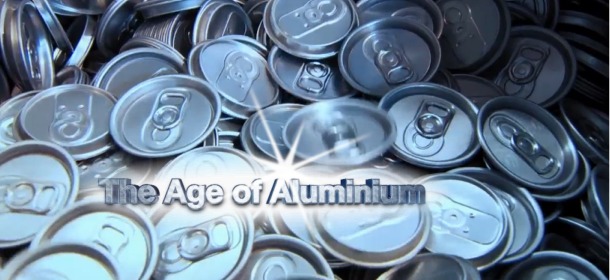Diseases/Conditions
Biological Effects of Aluminum: The Current Science
Aluminum is everywhere, in our cars, our food, our medical products and drugs, vaccines, and even our water. It was once safely sequestered in the earth’s crust, but now is torn from it to help produce every imaginable product under the sun—in spite of being a potent neurotoxin!
 by Heidi Stevenson
by Heidi Stevenson
This is the Age of Aluminum. As the scientific dean of aluminum’s biological effects, Dr. Chris Exley, says, “Pandora’s box has been opened.” We are living with aluminum in virtually every aspect of our lives, from structures to transportation to water supplies to cosmetic and health products to household cleaners to our food. It is in everything, including our bodies. The mad headlong rush to tear aluminum out of the earth leaves a swathe of destruction and destroyed lives behind it.
Aluminum is an exceptionally versatile chemically active element, which is why it’s ubiquitous in today’s world. However, it has no natural role in any biological form. It is a highly toxic poison. Unfortunately, as Dr. Exley’s apt metaphor suggests, we cannot simply close the lid. One way or another, we must live with it.
The problem in today’s society is that most of the financing for research is coopted by the profit imperative. As a result, far too little science is dedicated to concerns of aluminum’s toxicity or how to deal with it. Nonetheless, some intrepid researchers have turned their backs on the big money, instead dedicating themselves to matters of health and safety. They come together annually in the Keele Conference, which is led by Dr. Exley.
These researchers come from a wide array of fields, including medicine’s neurology, oncology, and endocrinology, chemistry, biology, biochemistry, agriculture, forestry, toxicology, microbiology, combinations of these, and other areas of expertise. In spite of a shortage in funding, the results are impressive.
Let’s take a look at the status of today’s research on the biological effects of aluminum.
Effects on Humans
The effects of aluminum on the central nervous system are being studied from several different angles. The latest Keele meeting covered a wide range of aspects:
- Parenteral nutrition—nutrients provided by means other than the mouth or alimentary canal, that is, by injection or intravenous infusion—has become common in premature newborns, severely ill, and elderly people. New research documents that the materials used to provide such nutrition leach into the sustenance and toxic levels enter the body, resulting in dangerously high levels of aluminum found in bones.
- Aluminum has adverse effects on gene expression, which affects the central nervous system and may be associated with essential hypertension.
- In the form of aluminum chloride, aluminum is responsible for DNA damage and rapid cell aging.
- Aluminum is found in significantly high concentrations in cancerous breasts. The high level of aluminum is associated with cancer-related abnormalities, including high levels of inflammatory cytokines and other pro-inflammatory substances.
- Aluminum adjuvants in vaccines persist in the body. They are known to cause the new neurological disorder, macrophagic myofasciitis.
- Although aluminum is excreted via the kidneys, their ability to do so is limited. Quantities that are not eliminated appear to have an affinity for endothelial cells lining cerebral blood vessels and possibly the brain, with likely downstream pro-inflammatory and pathogenic effects.
- Aluminum has been safely chelated using EDTA, with associated beneficial effects on multiple sclerosis patients.
- Aluminum-exposed workers are significantly more likely to develop cognitive disorders, such as Alzheimer’s disease.
- People in the upper quartile of aluminum toxicity are at three times the risk of developing diabetes.
Breast Cancer
Breast cancer is becoming more common every year and the National Cancer Institute is now reporting that a woman’s lifetime risk is 1 in 8. Dr. Philippa Darbre, who studies the association between breast cancer and aluminum, keeps tightening the noose around cause (aluminum) and effect (cancer) more and more tightly. As a scientist, she states that her work has not proven a cause-and-effect connection, and it certainly is true that other things, such as excess estrogen, factor into the issue.
Nonetheless, the association is clearly very strong, and her research has documented that there is a direct connection between the aluminum in antiperspirants and breast cancer. She and other researchers with whom she works have documented that:
- The aluminum in antiperspirants is readily absorbed through the skin.
- Breast cancer is most common in the upper outer quadrant of the breast, which is nearest to the armpit, where antiperspirants are used.
- Aluminum concentrations are highest in cancerous breast tissue and nipple aspirants of cancerous breasts.
- Aluminum interferes with estrogen binding.
- Breast cancer cells metastasize in the presence of aluminum, causing them to spread to critical organs.
There is now little doubt that there’s a strong association between aluminum in antiperspirants, along with other cosmetic products, and invasive breast cancer. While that does not necessarily mean that aluminum is the cause, it’s clear that avoiding it can limit one’s likelihood of either developing breast cancer or metastasis of existing cancer.
Plant Toxicity
Although aluminum has no place in any metabolic processes, some plants are able to resist its harmful effects, thus allowing them to grow in acidic aluminum-rich soils, and others are even able to utilize it for protection against insects. Very few plants that grow well in aluminum-rich soils are edible. Two exceptions, though, are tea and hydrangea, which is commonly used in fruity teas. Recent research has clearly documented that the amount of aluminum is significant.
Many parents allow their children to drink fruit teas in lieu of standard black or green teas in an effort to assure their health. Unfortunately, though, the great majority of fruit teas contain significant quantities of hydrangea. It may, therefore, be wise to read labels to determine whether hydrangea is present and limit access to such teas.
Agriculture & Environment
Though not currently in the news as it was two and three decades ago, acid rain’s effects have been dramatic by causing signficant harm in the ability of woodland and agricultural lands to grow plants, especially those on which we rely for food. Lands that had been suitable for farming have been rendered far less able to support agricultural crops. Some research has indicated that land may recover, but that recovery is slow. In the meantime, the resultant aluminum in acidic land interferes with our ability to feed ourselves, and once-verdant forests are now struggling.
Research into how acidic soil may be modified to make it more amenable for agriculture is ongoing. New results have documented that the unfortunate toxic effects of cations on plants may have the ironic effect of reducing the harm done by aluminum in soil. Other research in the area of aluminum’s effects in agriculture includes studies on its synergistic reactions with other elements, and species varieties more resistant to its toxicity.
Long term dialysis patients whose water supply is purified using aluminum floccation are at high risk of developing dementia. As Age of Aluminum documents, the rate of Alzheimer’s disease is double in areas where aluminum is used for water purification.
Vaccines
A vaccine adjuvant is a substance that increases the body’s immune response for the purpose of creating antibodies to an antigen. By far, the most commonly used adjuvant is aluminum. The standard claim is that the practice is safe because the amount of aluminum is too small to be harmful. In reality, this assumption was never tested and new research is bringing that assumption into question.
It has been presumed that, because the kidneys normally flush aluminum out of the system, injected aluminum should not persist. Recent research turns that idea on its ear. Not only can aluminum enter the brain, its path there has now been documented.
Mitochondria are mini-cells within cells where energy is produced to support cellular function, and therefore life itself. The latest Keele Conference hosted a report documenting that mitochondria are damaged by aluminum adjuvants included in vaccines. The same meeting also saw a report documenting that aluminum administered in doses equivalent to what’s given to humans results in long-term adverse neurological outcomes in mice. Another report documented the death of one girl that could be explained only by an aluminum-adjuvanted vaccination she’d received.
Alzheimer’s Disease
Researchers who’ve reported at the Keele Conference have been key in documenting that the dementia known as Alzheimer’s disease is associated with aluminum. Whether it’s a cause or an aggravation of an existing condition is as yet unknown. However, it is known that people who live in areas where the water is purified with an aluminum compound have double the rate of this debilitating disease. Some researchers are working to reduce this toll by finding ways to reduce the amount of aluminum that escapes into the drinking water.
Other researchers are focused on methods of treating Alzheimer’s disease. There is some promising work with silicic acid, which may be able to attach to aluminum and pull it out of the body. Christopher Exley has suggested that drinking water with high silicic acid content may help detox aluminum from the body.
Water Supplies
In today’s world, it isn’t possible for most people to simply go to the nearest river or well to obtain water. The massive numbers of people make water purification an unavoidable necessity. One of the most important processes is flocculation, the process of collecting tiny particles into bunches so that they can be removed. The most common chemical used today is aluminum sulphate.
Aluminum is a highly reactive element, which is what makes is so biologically active and useful in so many applications. When added to water in the form of aluminum sulphate, that reactivity draws a large percentage of particulate matter to it, so it forms small clumps, which sink to the bottom, making it possible to separate them from the now much-purified water.
The problem is that the resultant water still contains low concentrations of aluminum. Unfortunately, studies have documented that people living in areas that utilize aluminum sulphate-based flocculation systems have double the rate of Alzheimer’s disease!
Since iron can also be used as a flocculant and its toxicity is quite low relative to aluminum, it would seem that switching to an iron-based system is the obvious solution. The problem is that it requires retooling a water purification system, which is expensive. We are, therefore, fortunate that there are teams of scientists who are trying to minimize the amount of aluminum that escapes into our water supply.
Sources:
Effects on Humans:
- Age dependence in the accumulation and elimination of aluminum in rats. Marlei Veiga, Sandra Ribeiro, Patricia Mattiazzi, Cristina Bandero, Queli Lenz, Mauro Silveira, Carlos Mello, Denise Bohrer: Presentation at the 10th Keele Meeting (page 57).
- Excessive aluminium accumulation in the bones of patients on long term parenteral nutrition. Pamela C. Kruger, Aubrey L. Galusha, Lyn Howard, and Patrick Parsons: Presentation at the 10th Keele Meeting (page 68).
- Absorption and metabolism of aluminum, and its influence on gene expressions to cause diseases. Shunsuke Meshitsuka: Presentation at the 10th Keele Meeting (page 73).
- Aluminum Chloride Transforms Cultured Mammary Epithelial Cells. Stefano J. Mandriota, Raphaële Buser, Laurence Lesne, Marc Ansari, Fabienne Gumy-Pause, Dominique Belin, and André-Pascal Sappino: Presentation at the 10th Keele Meeting (page 74).
- Relationship among Aluminium, Carbonyls and Interleukinds in normal and cancerous breast microenvironment. Ferdinando Mannello, Daniela Ligi, Matteo Canale: Presentation at the 10th Keele Meeting (page 75).
- Aluminum hydroxide-induced macrophagic myofasciitis (MMF): predictive scores and biomarkers: Nilusha Ragunathan-Thangarajah, Christine Le Beller, Anne Fustier, Jean-Louis Brasseur, Romain K. Gherardi, Pierre Boutouyrie, Stéphane Laurent, François Jérôme Authier: Presentation at the 10th Keele Meeting (page 78).
- Aluminium entry into the brain: studies in the cerebral vasculature and in human brain microvessel endothelial (hBMED) cells. Walter J. Lukiw, Brandon M. Jones, Jian-Guo Cui, Yuan Yuan Li, S. Bhattacharjee, James M. Hill, Yuhai Zhao, Theodore P. A. Kruck, Maire E. Percy, JR Walton, and Aileen I. Pogue: Presentation at the 10th Keele Meeting (page 88).
- Relationship of aluminlum intoxication with neurodegenerative diseases. Alessandro Fulgenzi and Maria Elena Ferrero: Presentation at the 10th Keele Meeting (page 90).
- Cognitive disorders and tau-protein expression amoung retired smelting workers exposed to aluminium. Xiao-ting Lu, Rui-feng Liang, Zhi-jian Jia, Hao Wang, Bao-long Pan, Qin-li Zhang, Wei-li Guo, Xiu-liang Ji, and Qiao Niu: Presentation at the 10th Keele Meeting (page 93).
- Aluminium, Copper, Zinc, Iron, Lead and diabetes risk in a colorectal screeening. A. Polizzi, M. Ferrara, M. Bugiani, A. Schiavone, P. Panarisi: Presentation at the 10th Keele Meeting (page 95).
Breast Cancer:
- Effect of aluminium on migratory and invasive properties of human breast cancer cells in culture.
Philippa Darbre, University of Reading, Reading, UK: : Presentation at the 10th Keele Meeting
- Aluminum in human breast tissue. Journal of Inorganic Biochemistry; Christopher Exley, Lisa M Charles, Lester Barr, Claire Martin, Anthony Polwart, Philippa D Darbre; doi: 10.1016/j.jinorgbio.2007.06.005.
- Aluminum, antiperspirants and breast cancer. Journal of Inorganic Biochemistry; PD Darbre; doi: 10.1016/j.jinorgbio.2005.06.001.
- Analysis of aluminium content and iron homeostasis in nipple aspirate fluids from healthy women and breast cancer-affected patients. Journal of Applied Toxicology; Ferdinando Mannello, Gaetana A. Tonti, Virginia Medda, Patrizia Simone, Philippa D. Darbre; DOI: 10.1002/jat.1641.
- Concentration of aluminium in breast cyst fluids collected from women affected by gross cystic breast disease. Journal of Applied Toxicology; Ferdinando Mannello, Gaetana A. Tonti, Phiippa D. Darbre; DOI: 10.1002/jat.1384.
Plant Toxicity:
- Effect of Aluminum Ions on Hydrangea Sepals and Viburnum Drupes. Blaine B. R. Groat and Henry D. Schreiber: Presentation at the 10th Keele Meeting (page 35).
- Amelioration of iron toxicity, a mechanism for aluminium induced growth stimulation in tea plants.Roghieh Hajiboland, Roser Tolrà, Juan Barceló, and Charlotte Poschenrieder: Presentation at the 10th Keele Meeting (page 37).
- Aluminium and other elements in selected herbal tea plant species and their infusions; Food Chemistry, Malik J, Frankova A, Drabek O, Szakova J, Ash C, Kokoska L; doi:10.1016/j.foodchem.2013.02.013.
Agriculture & Environment:
- Long term changes in aluminium concentrations and fluxes in Czech streams recovering from acidification. Pavel Kram, Oldrich Myska, Jakub Hruska, Vladimir Majer, Anna Lamacova, and Filip Oulehle: Presentation at the 10th Keele Meeting (page 37).
- Molecular Mechanisms of Crop Adaptation to Acid Soils. Leon Kochian, Jiping Liu, Jurandir Magalhaes, Miguel Pinéros, Lyza Maron, Jon Shaff, and Claudia Guimaraes: Presentation at the 10th Keele Meeting (page 33).
- Labile Al content or BC/Al ratio in soil: what controls tree seedlings growth? Luboš Borůvka, Marek Batysta, Václav Tejnecký, Ondřej Drábek, Antonín Nikodem, and Josef Kratina: Presentation at the 10th Keele Meeting (page 45).
- Water supply aluminium concentration, dialysis dementia, and effect of reverse-osmosis water treatment. The Lancet; Davison AM, Walker GS, Oli H, Lewins AM; PMID: 6126664.
Vaccines:
- Long term changes in aluminium concentrations and fluxes in Czech streams recovering from acidification. Pavel Kram, Oldrich Myska, Jakub Hruska, Vladimir Majer, Anna Lamacova, and Filip Oulehle: Presentation at the 10th Keele Meeting (page 37).
- Aluminium adjuvantinduced mitochondrial alterations. Lars Ohlsson, Anna Darabi, Peter Siesjö, and
Håkan Eriksson: Presentation at the 10th Keele Meeting (page 60). - Administration of aluminium in vaccine-relevant exposures in neonatal mice is associated with long-term adverse neurological outcomes. Lucija Tomljenovic, Yongling Li, Christopher Shaw: Presentation at the 10th Keele Meeting (page 61).
- Death following human papillomavirus virus (HPV) vaccination: an autoimmune adjuvant-mediated adverse reaction?. Lucija Tomljenovic and Christopher Shaw: Presentation at the 10th Keele Meeting (page 79).
Alzheimer’s Disease:
- A molecular mechanism of aluminium-induced Alzheimer’s disease? Journal of Alzheimer’s Disease; Christopher Exley; doi: 10.1016/S0162-0134(99)00125-7.
- Silicon-rich mineral water as a non-invasive test of the ‘aluminum hypothesis’ in Alzheimer’s disease. Journal of Alzheimer’s Disease; Davenward S, Bentham P, Wright J, Crome P, Job D, Polwart A, Exley C; doi: 10.3233/JAD-2012-121231.
- Non-invasive therapy to reduce the body burden of aluminium in Alzheimer’s disease. Journal of Alzheimer’s Disease; Exley C, Korchazhkina O, Job D, Strekopytov S, Polwart A, Crome P; PMID: 16988476.
- A systems biology approach to the blood–aluminium problem: The application and testing of a computational model. Journal of Inorganic Biochemistry; James Beardmore, Gordon Rugg, Christopher Exley; doi: 10.1016/j.jinorgbio.2007.06.015.
- Silicic acid (Si(OH)4) is a significant influence upon the atomic absorption signal of aluminium measured by graphite furnace atomic absorption spectrometry (GFAAS). Journal of Inorganic Biochemistry; Celine
Schneider, Christopher Exley; doi: 10.1016/S0162-0134(01)00313-0. - Metals accelerate the formation and direct the structure of amyloid fibrils of NAC. Journal of Inorganic Biochemistry; Ayesha Khan, Alison E. Ashcroft, Valerie Higenell, Olga V. Korchazhkina, Christopher Exley; doi:10.1016/j.jinorgbio.2005.06.018.
Water Supplies:
- Can Al3+ promote the Fenton reaction and oxidative stress? Xabier Lopez, Euskal Herriko University, Donostia, Basque Country: Presentation at the 10th Keele Meeting
- Municipal solid waste landfill leachate treatment by fenton, photo-fenton and fenton-like processes: Effect of some variables; Journal of Environmental Health Science & Engineering, Mohammad Ali Zazouli, Zabihollah Yousefi, Akbar Eslami, and Maryam Bagheri Ardebilian; doi:10.1186/1735-2746-9-3.
Tagged aluminum acid rain, aluminum agriculture, aluminum alzheimer’s disease, aluminum biological effects, aluminum breast cancer, aluminum darbre, aluminum environment, aluminum estrogen, aluminum neurotoxin, aluminum soil, aluminum vaccines, aluminum water, biological effects of aluminum aluminum keele conference, christopher exley, environment, keele conference, science














Pingback: Aluminiowy biznes | Naukowy i Techniczny Blog